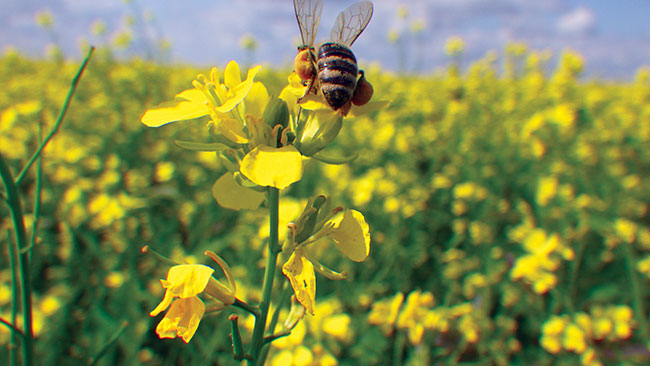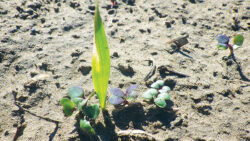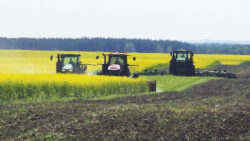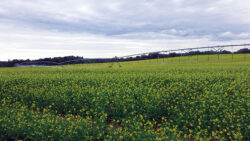
Features
Diseases
Hot-headed mustard improves biofumigation
New research suggests Verticillium wilt disease management is possible with the right variety and biofumigation method.
July 11, 2023 By Rosalie I. Tennison
 A bee visits a mustard field. Mustard has been used by potato growers as a cover crop for biofumigation.
Photo courtesy of Zack frederick.
A bee visits a mustard field. Mustard has been used by potato growers as a cover crop for biofumigation.
Photo courtesy of Zack frederick. Inconsistent results from using biofumigation to control Verticillium wilt and other soil-borne pathogens in potatoes has soured some growers on using this viable disease control option. Growing a non-money-making crop in the hopes the cost will be recouped the following year with lower pest and disease pressure and improved yields puts some growers off attempting the procedure. However, new research in Manitoba is showing that using mustard for biofumigation can be very successful. The tactic to achieve success is to seed a variety of mustard proven to offer the best fumigant properties and to faithfully follow the guidelines developed by researchers.
For basic biofumigation success, growers need a crop that produces a high amount of biomass in a short growing period and that will offer the highest output of fumigant properties once incorporated into the soil. Many crops, such as sorghum, buckwheat, rapeseed and others, can be used as cover crops for biofumigation. But the most successful for potato growers is mustard.
“Planting into soil infected with Verticillium wilt can lead to the loss of up to half the crop,” says Dr. Zack Frederick, the applied potato research agronomist for Manitoba Horticulture Productivity Enhancement Centre (MHPEC) in Carberry. Commercial fumigants can be toxic and have an environmental impact, he continues, and that is why he has been focussing his work on crops that act successfully as biofumigants. “Mustard can control Verticillium but is markedly less toxic.”

Mustard and cover crop emerging several weeks after being planted.
Photo courtesy of Zack Frederick.
Mustard has been used for biofumigation over the years but with mixed results. Frederick believes the variety of mustard used is the problem. In fact, growers can’t rely on just any garden variety mustard. Instead, they need to use cultivars specifically bred for biofumigation and the best varieties were originally bred in Italy.
“We are working with a variety of mustard – Caliente Rojo – that is too spicy for human consumption, but is toxic to Verticillium in the soil,” Frederick explains. “We are now working to determine if the cost of the mustard seed justifies its use as a biofumigant.”
The efficacy of Caliente Rojo is not lost on the seed provider in Washington, who is working with breeders in Italy to improve the attributes of the variety. “I’m not a plant breeder, but I can evaluate plants in the field and mustard has a chemistry that will help potato growers control diseases,” says Dale Gies of High Performance Seeds. “Caliente Rojo is the best variety for the purpose because only a handful of mustard varieties have the capability to biofumigate.” He says the Italian breeders are currently improving Caliente Rojo to get consistent results and with enough biomass and glucosinolates to get the job done.

Biofumigation setup with tractors, flails and discs.
Photo courtesy of Zack Frederick.
Growers whose experience with biofumigation was unsuccessful need to understand that more is required than just the right plant. The entire process of biofumigation in a field requires timing, the correct amount of moisture, and effective harvest and integration of the crop.
“It’s not as simple as we thought,” admits Gies. “We’ve identified the needed compounds and now work is being done to measure how much biomass is needed to be effective when combined with soil conditions. We’ve learned from laboratory work that biofumigation can be successful, but we have to be able to replicate it in the field.”
In Manitoba, field replication using the Caliente line of mustards is still a few years away. Frederick and his colleague, Haider Abbas of Manitoba Agriculture’s Crop Diversification Centre in Carberry, have tested other varieties of mustard to try to identify the amount of glucosinolate each produces and the amount of biomass. “Our core purpose is to achieve high biomass,” Abbas reports. “Because the plants are chopped and the resulting biomass is sealed into the soil for the winter, the greater the amount of biomass achieved the better.”
The researchers also discovered that some mustards are better at controlling certain pests than others, so they envision a future where growers would identify the pest they want to suppress prior to their potato crop and then seed the mustard variety that is most effective. Growers can find guidelines for successful biofumigation on the MHPEC website (mbpotatoresearch.ca/research-reports). The report covers the best practices for planting the recommended mustard variety to fertility to eventual incorporation of the mustard crop.
“When using the Caliente Rojo variety, growers need to be prepared to irrigate,” Frederick explains. “A lot of water is needed to grow Caliente and I like to see the crop at least five feet tall. Preferably, about eight inches of water is needed by the seed. Once the plants have reached their height before seed set, the mustard needs to be destroyed and then ploughed into the soil.”
Frederick says harvesting after a heavy frost is good because the cold, brittle plants can be flailed into smaller pieces that are then incorporated into the soil.

Mustard being irrigated.
Photo courtesy of Zack Frederick.
“If the strict protocol we have developed is followed, this means biofumigation works,” Frederick says. He admits that using mustard as a biofumigant could add $250/acre to the cost of growing potatoes. But he also points out that the cost of commercial products to control Verticillium or other pests and diseases will be saved. Frederick adds that mustard biofumigation could offer multiple values, such as also reducing common scab and reduction of wind erosion. Work will proceed towards developing definitive production and results information but, he says, it could be 2024 before those recommendations are available to growers.
Meanwhile, Gies plans to continue searching for the best variety to achieve effective, predictable biofumigation. “We think we understand how this all plays out but we still have a lot to learn in terms of efficiency,” he admits. “We say biofumigants are ‘some assembly required’. We can do anything commercial chemicals do with biofumigation, but we need a variety that is consistent and forgiving, heat tolerant, and grows quickly. Also, a variety with winter tolerance would be really useful because it is hard to time the planting for effectiveness.”
Gies will continue to talk to the breeders in Italy about developing the perfect mustard for potato growers’ use. Frederick and Abbas will hone the process of producing the best biofumigation process using the available Caliente Rojo variety. What is promising in the ongoing research is that effective biofumigation is possible according to the present recommendations, so potato growers can start reaping the benefits.
Print this page